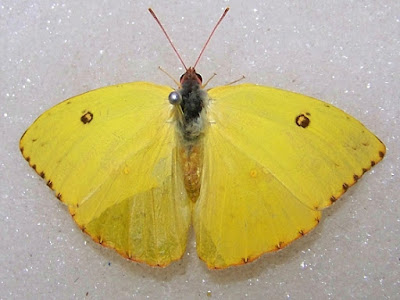 |
| Cloudless Sulfur - Bob Moul |
When it comes to insect migration, we think of the dramatic Monarch migration, one of the wonders of nature. Dragonflies like the Green Darner can sometimes be seen migrating in dramatic numbers. There are however a lot of other smaller scale migrations that are so subtle they are often overlooked. Most migrations of insects are noted by the appearance of seasonal increases in a regional population.
The Cloudless breed continuously in the tropics and twice a year in the southern US. Some migrate north as far as Canada in middle summer where they find the warmth they need. They feed on woody and herbaceous legumes which span from alfalfa and soybeans to the leaves of black locust. Whether they are driven to migrate north by host plant availability or by temperature gradient is known only by the butterflies and they aren't talking.
The migration of Monarchs tends to occur at higher altitudes while the Cloudless travel in a zone from within 10 feet of ground level. When they encounter a house or some other obstacle they tend to fly over it rather than temporarily change direction.*
Cloudless survive the winter as adults and they don't tolerate cold. In the fall, large numbers move south in response to cooling temperatures. Those that chose not to go or take off too late will mostly perish.
The Cloudless sulfur, Phoebis sennae, looks superficially like other sulfur butterflies in its usual wing folded position. The underside of the wings is between a yellow to pale green color with two small silver spots and a black rim on the hind wing which defy the naked eye when they are resting.
 |
| Dogface Sulfur - REK |
 |
| Clouded Sulfur - Wikimedia |
The upper wing surface is easier to identify but virtually impossible to photograph without capturing the insect. The above chilled and released Southern Dogface shows its namesake and the Clouded Sulfur has "clouds" on the dorsal wing edges. The Cloudless shows the clouds are gone.
 |
| Cloudless Sulfur - ColtonEnto |
 |
| Terry Schiff CC |
 |
| Sue Carnahan CC |
Many other lepidoptera migrate including the Red Admiral, Common Buckeye, American Lady and the colorful Alianthus Webworm Moth.
* More details of Cloudless Sulfurs and their migration is at this University of Florida Entomology site.